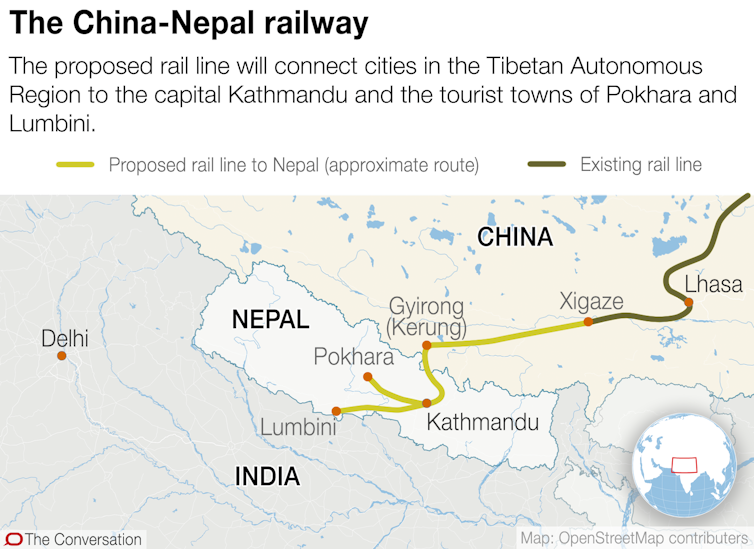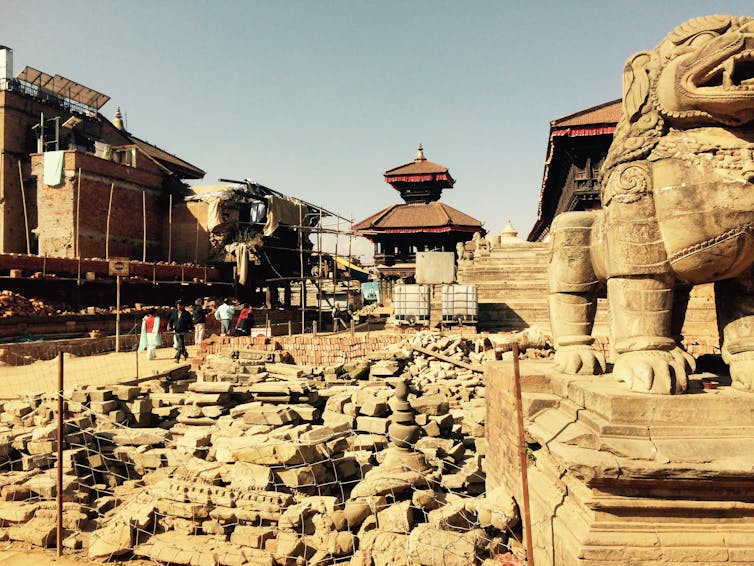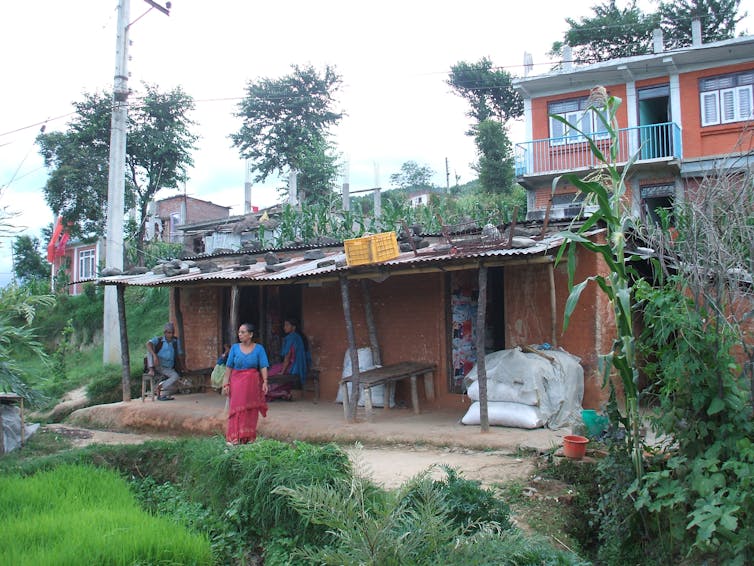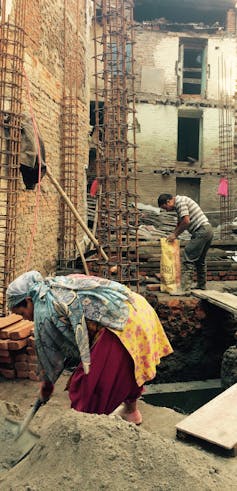Tag Archives: Nepal
Coronavirus Update
Australia
Nepal
USA
Coronavirus Update: International
France
United Kingdom
Nepal
Singapore
USA
Will an ambitious Chinese-built rail line through the Himalayas lead to a debt trap for Nepal?

Author provided
Jagannath Adhikari, Curtin University
China’s Belt and Road Initiative (BRI) has ambitions to reshape the global economy by connecting more than 60 countries across Asia, Europe and Africa through trade and infrastructure projects. All told, it’s envisioned that nearly two-thirds of the world’s population will in some way be connected through BRI projects in the future. Some economists estimate BRI could increase global trade by 12%.
Despite these benefits, many questions have been raised about China’s motivations for the initiative, and whether Beijing can afford the US$1 trillion it has committed to infrastructure projects and its partners can afford the debt they are taking on. Some fear BRI could be a Trojan horse for global domination through debt traps.
Sri Lanka is often cited as a cautionary tale. Unable to repay the loans on a US$1.5 billion port construction project, the Sri Lankan government agreed to give China a 99-year lease on the port instead. The ports and shipping minister said at the time:
We had to take a decision to get out of this debt trap.
Nepal takes the plunge
Despite fears over loans they can’t pay back, many small countries have accepted BRI as an alternative pathway to economic prosperity. Nepal is one of them – it entered into BRI last year with great enthusiasm.
Then in June of this year, Nepali Prime Minister K.P. Sharma Oli travelled to China to sign agreements worth US$2.4 billion on everything from infrastructure and energy projects to post-disaster reconstruction efforts.
Read more:
Soft power goes hard: China’s economic interest in the Pacific comes with strings attached
The highlight of the deals is an audacious plan to build a railway line through the Himalayas. The line will link the Tibetan border town of Kerung with the Nepali capital, Kathmandu, and tourist towns of Pokhara and Lumbini (Buddha’s birthplace). The railway is being trumpeted as a potential windfall for Nepal’s tourism industry, with some 2.5 million Chinese tourists expected to visit annually.

CC BY-ND
If the rail line is developed as proposed, Nepal would also be well placed as a major transit hub for trade between China and its rival, India. One study estimates Nepal’s trade could be boosted by 35% to 45% when the rail line and other BRI infrastructure projects are completed.
The Chinese government has already conducted a pre-feasibility study on the Kerung-Kathmandu railway. It estimated the 72.25km line from the Chinese border to Kathmandu would cost US$2.25 billion. (Other estimates say the cost might be much more.) Nepali railway officials say an incredible 98.5% of the line would run through tunnels and across bridges due to the forbidding, mountainous terrain.
Is Nepal falling into a debt trap?
The main debate in Kathmandu now is whether this proposed rail line is technically and financially feasible, and if it is someday completed, whether it’s destined to become a white elephant – an expensive but vastly underutilised transportation line.
Then there is the question of cost. Besides Sri Lanka’s struggles to pay back the US$8 billion in total it now owes Chinese firms, many other countries are in similar straits.
Economists worry that Laos, which has seen its debt reach 68% of GDP, will have difficulty paying off its share of a US$6 billion rail line being built by China. And in the Maldives, the opposition claims the country is facing a looming debt trap, with US$92 million in annual payments due to China to pay off an airport upgrade and bridge project – roughly 10% of the entire budget.

CC BY-ND
In Nepal, the burning question has been whether the trans-Himalayan rail line and other infrastructure projects would be built with similar loans, or if the government would be able to secure grants from China instead.
Economists and planners in Nepal believe the rail line would be beneficial to the country’s development, particularly because it would end Nepal’s reliance on its traditional ally, India, for trade, fuel, food and medical supplies.
A two-month blockade of the main trade route between Nepal and India in 2015 gave Nepali politicians greater rationale for diversifying the country’s trade partners and becoming better connected to global trade routes. The greater connectivity with China is also expected to boost Nepali exports of special herbs and agricultural products that are in high demand in China.
Read more:
The Belt and Road Initiative: China’s vision for globalisation, Beijing-style
But given the debt problems in Sri Lanka and other countries, the previous Nepali government was initially hesitant to follow the same path in its dealings with China. Last year, it pulled the plug on a US$2.5 billion hydropower plant being built by a Chinese firm because of the lack of a competitive bidding process.
But since Oli returned to power in February, he has pursued much more Beijing-friendly policies. Last month, he reinstated the hydroelectric plant contract. And though Nepal is still seeking grants from China to build the trans-Himalayan railway, it’s unclear whether Oli will make this a precondition to starting construction.
China is offering soft loans to fund the railway instead. It also sweetened the deal in September by giving Nepal access to four of its seaports, which will give Kathmandu a viable trade alternative to Indian ports for the first time.
Thus far, Nepal and China have not come to an agreement on the funding question over the BRI projects and construction has yet to start.
Thinking beyond debt traps
Indian politicians and media outlets have been sceptical of China’s efforts to woo Nepal, raising fears that BRI is a masquerade for Chinese domination through debt-swap arrangements. But India’s real concern is losing its long-standing influence over Nepal, with which it enjoys a US$5 billion trade surplus.
For Nepal and other small countries in the region, however, the benefits that BRI can bring – namely improved infrastructure and greater connectivity to the world – do appear to be too good to pass up. After all, Nepal’s main concern is economic growth, development and improved livelihoods for its people.
Read more:
China’s Eurasian gambit needs to be taken seriously
For the country to truly benefit from these projects, it needs to enter into them cautiously, with the right funding plans in place. The government views these projects as potentially massive political victories and could overlook concerns over safety issues and financing when signing deals with China.
But Nepal must not fall into the same debt trap as Sri Lanka; otherwise, its aspirations of a brighter future could turn into a mirage.![]()
Jagannath Adhikari, Adjunct Research Fellow, School of Design and the Built Environment, Curtin University
This article is republished from The Conversation under a Creative Commons license. Read the original article.
Nepal earthquake reconstruction won’t succeed until the vulnerability of survivors is addressed

Jason von Meding, Author provided
Jason von Meding, University of Newcastle; Hari Darshan Shrestha; Humayun Kabir, University of Dhaka, and Iftekhar Ahmed, University of Newcastle
In April 2015 the Gorkha earthquake brought Nepal’s vulnerability sharply into focus. Alongside massive damage to the built environment, the terrible impact on the people of Nepal sent shockwaves around the world.
Despite good intentions to rebuild Nepal to be more resilient, 30 months on little progress has been made. Of more than 400,000 homes that were earmarked for reconstruction, only 12% have been rebuilt. Little of the US$4.4 billion in aid pledged for reconstruction has been disbursed.
The Nepali government instituted a reconstruction program in October 2015 that identifies beneficiaries and entitles them to three instalments of compensation. The payments are dependent on progress and building code compliance. Those who do not own land are locked out of reconstruction support.
Read more: The science behind the Nepal earthquake
Nepal has robust building codes, developed over recent years. Serious efforts to implement the codes predate the Gorkha earthquake.
Unfortunately, despite such efforts, there are still more than five million existing buildings standing after the earthquake that are not to code. Many of these are “informal” and built by traditional masons. There is also a large stock of old, dilapidated buildings. These buildings will be a particular risk in Nepal when future earthquakes strike.
Widespread retrofitting would protect lives and property in the future. Strictly speaking, all new buildings must meet the code – something difficult to monitor and enforce. Forcing people into compliance also has drawbacks: it can lead people to bypass it by unlawful means, and can be particularly onerous for the poor.
Nepal needs a strategy for “safe building” that is acutely aware of the resource inequalities and other social impediments that block progress on code compliance.

Ifte Ahmed
Housing typology and quality in Nepal
Of the more than 600,000 buildings that were fully damaged by the earthquake, most predated building codes and were built from stone and mud. The death toll of around 9,000 was lower than may have been expected, considering the number of buildings destroyed. By contrast, the 2010 Haiti earthquake is estimated to have claimed more than 300,000 lives while fewer than 300,000 buildings were fully damaged.
Read more: Two years after the earthquake, why has Nepal failed to recover?
Traditional building knowledge is clearly a valuable asset in determining how to save lives in an earthquake – but technical advances have been made that must now be integrated during reconstruction. The five million buildings that survived the earthquake require urgent retrofitting.
In Nepal, 80% of human settlement is often referred to as “informal”. These are households that are not in compliance with building norms and planning regulations. This can be a measure of marginalisation and can bring spatial segregation and discriminatory treatment.
In addition, Nepal is rapidly urbanising. The temptation in urban areas is to build higher, but in a country like Nepal this could have fatal consequences in an earthquake. Local engineers fear mass casualties if heavy, reinforced concrete structures (as are being widely built) collapse in the future.
Why has reconstruction stalled?

Jason von Meding
The government housing grant is available in three instalments on the basis of progress; Rs50,000 (US$477) upon signing an agreement; Rs150,000 (US$1,437) after completion up to plinth level; and Rs100,000 (US$958) upon completion of the structure.
More than 400,000 households entered into an agreement, but so far only 12% have completed the program.
The National Reconstruction Authority (NRA) undertook a lengthy consultation period in the name of building back better. Development of a building code compliance process and a catalogue on rural housing took 18 months to produce and disseminate.
By the time guidance was finally available, many beneficiaries had spent the first instalment on other priorities – many of those affected struggle to provide for the basic needs of their families.
Due to the remoteness of many reconstruction properties in the mountainous terrain, checking for compliance is a major challenge. In addition to the delays in establishing a suitable mechanism, the NRA has been unable to provide enough technical experts in remote, rural areas to implement their own policy.
Read more: What can tourists do to help, not hinder, Nepal’s quake recovery?
Safe, affordable and high quality construction is possible
Safe building is inherently difficult in a developing country like Nepal. For many people, putting food on the table is a daily struggle. Investing in earthquake-resistant housing measures is simply not within reach.

Jason von Meding
In such situations, people are forced to accept acute risk in the course of just surviving. This includes living in buildings that might fall down at any time. In Nepal, people have continued with life since the 2015 earthquake and have reoccupied dangerous premises.
Beyond simply improving the effectiveness of building code enforcement, it’s important we don’t neglect social and economic aspects of the dilemma in Nepal. While affordability is critical, quality is achievable by adapting Indigenous building techniques. If safe building is valued, people would voluntarily comply with codes and regulations.
![]() The potential for change will be wasted if we fail to understand and address the chronic vulnerability of people recovering from this disaster. Not everyone has the same access to opportunities and resources – so better codes and regulations only go so far.
The potential for change will be wasted if we fail to understand and address the chronic vulnerability of people recovering from this disaster. Not everyone has the same access to opportunities and resources – so better codes and regulations only go so far.
Jason von Meding, Senior Lecturer in Disaster Risk Reduction, University of Newcastle; Hari Darshan Shrestha, Associate professor Disaster Management and structural Engineering; Humayun Kabir, Professor, DRR expert, University of Dhaka, and Iftekhar Ahmed, Senior Lecturer, University of Newcastle
This article was originally published on The Conversation. Read the original article.
Nepal: Persecution News Update
The link below is to an article that takes a look at persecution news from Nepal.
For more visit:
http://www.christianitytoday.com/news/2017/october/nepal-criminalizes-conversion-christianity-evangelism-hindu.html
Nepal: Persecution News Update
The links below are to articles reporting on persecution and related news from Nepal (the most recent are at the top).
For more visit:
– http://www.persecution.org/2017/09/28/four-nepali-christians-released-after-nine-months-of-wrongful-imprisonment/
– http://christiannews.net/2017/09/26/nepali-christians-freed-nine-months-after-conviction-for-witchcraft-of-praying-for-mentally-ill-woman/
– http://kathmandupost.ekantipur.com/news/2017-09-15/from-terror-to-tolerance.html
– http://www.asianews.it/news-en/Nepals-new-criminal-code-punishes-all-religious-conversions-41746.html
Nepal: Persecution News Update
The links below are to articles reporting on persecution news from Nepal.
For more visit:
– https://www.worldwatchmonitor.org/2016/08/4591743/
– http://www.interamerica.org/?p=23784#axzz4Hgq5ecLB
Nepal: Persecution News Update
The link below is to an article reporting on persecution news from Nepal.
For more visit:
http://www.christiandaily.com/article/christianity-is-unexpectedly-on-the-rise-in-nepal/52283.htm
Nepal: Persecution News Update
The links below are to articles reporting on persecution news from Nepal (the most recent are at the top).
For more visit:
– http://www.christianitydaily.com/articles/6250/20151001/extremist-hindu-group-nepal-threatens-christian-missionaries-leave-country.htm
– http://www.charismanews.com/world/52311-radicals-arrested-after-church-bombings-rock-assembly
– http://www.christiantoday.com/article/christian.missionaries.told.to.leave.nepal/66085.htm
– https://www.worldwatchmonitor.org/2015/09/4032838/

You must be logged in to post a comment.